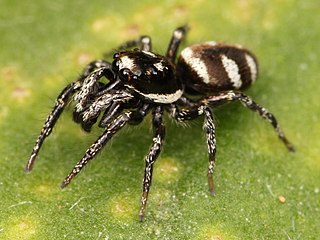Related Research Articles

The zebra spider is a common jumping spider of the Northern Hemisphere. Like other jumping spiders it does not build a web. It has a particularly large pair of forward facing eyes that help it to locate and stalk its prey before pouncing on it. Their common name refers to their vivid black-and-white colouration, whilst their scientific name derives from Salticus from the Latin for “dancing”, in reference to their agility, and the Greek scenicus, translating to “theatrical” or “of a decorative place,” in reference to the flashy, zebra-like coloration of the species.

Araneus is a genus of common orb-weaving spiders. It includes about 650 species, among which are the European garden spider and the barn spider. The genus was erected by Carl Alexander Clerck in 1757.

Eresus, also called ladybird spiders, is a genus of velvet spiders that was first described by Charles Athanase Walckenaer in 1805. Members of the genus formerly called Eresus cinnaberinus or Eresus niger are now placed in one of three species: Eresus kollari, Eresus sandaliatus and Eresus moravicus.

Missulena is a genus of mygalomorph spiders in the family Actinopodidae, sometimes called mouse spiders. It was first described by Charles Athanase Walckenaer in 1805. M. tussulena is found in Chile, but the rest are indigenous to Australia.
Damoetas is a monotypic genus of Australian jumping spiders containing the single species, Damoetas nitidus. It was first described by George and Elizabeth Peckham in 1886, and is only found in New South Wales and Queensland. Two species that were once in this family, Damoetas christae and Damoetas galianoae have since been moved to Myrmavola.

Hypoblemum is a genus of South Pacific jumping spiders that was first described by George and Elizabeth Peckham in 1886. The taxonomy was radically revised in 2019.

Messua is a spider genus of the family Salticidae.
Ogdenia is a monotypic genus of jumping spiders containing the single species, Ogdenia mutilla. It was first described by George Peckham in 1907, and is only found on Borneo.

Salticus is a genus of the family Salticidae. Salticus is the type genus for the family Salticidae.
Titanattus is a genus of jumping spiders that was first described by George and Elizabeth Peckham in 1885. The name is a combination of "Titan" and the common salticid suffix -attus. It was merged with Agelista in 2017.
Yllenus is a genus of jumping spiders that was first described by Eugène Louis Simon in 1868. Until 2019, it was considered a senior synonym of Pseudomogrus, and many of the species formerly placed here were transferred to new genera Logunyllus and Marusyllus by Jerzy Prószyński in 2016.

Zygoballus is a genus of jumping spiders found in North and South America.

George Williams Peckham and Elizabeth Maria Gifford Peckham were a married couple who were early American teachers, taxonomists, ethologists, arachnologists, and entomologists, specializing in animal behavior and in the study of jumping spiders and wasps.

Zygoballus sexpunctatus is a species of jumping spider which occurs in the southeastern United States where it can be found in a variety of grassy habitats. Adult spiders measure between 3 and 4.5 mm in length. The cephalothorax and abdomen are bronze to black in color, with reddish brown or yellowish legs. The male has distinctive enlarged chelicerae and front femora. Like many jumping spiders, Z. sexpunctatus males exhibit ritualized courtship and agonistic behavior.

Zygoballus rufipes, commonly called the hammerjawed jumper, is a species of jumping spider which occurs in the United States, Canada, and Central America. Adult females are 4.3 to 6 mm in body length, while males are 3 to 4 mm.

Zygoballus iridescens is a species of jumping spider which occurs in the United States. It is known only from a single female specimen collected in Franconia, New Hampshire by Annie Trumbull Slosson.

Nyssus is a genus of corinnid sac spiders first described by Charles Athanase Walckenaer in 1805.
Massagris mirifica is a jumping spider species in the genus Massagris that lives in South Africa. The male was first identified by George and Elizabeth Peckham in 1903.
Habronattus elegans is a species of spiders in the family Salticidae. It is found in the United States and in Mexico.
Mexcala elegans is a species of spiders in the jumping spider family, Salticidae. It is found in Southern Africa. It is preying on ants.
References
- 1 2 Proszynski, Jerzy (2002). "Attus". Catalogue of Salticidae (Araneae). Retrieved 2009-11-23.
- ↑ Walckenaer, Charles Athanase (1805). Tableau des aranéides ou caractères essentiels des tribus, genres, familles et races que renferme le genre Aranea de Linné, avec la désignation des espèces comprises dans chacune de ces divisions (in French). Paris.
- ↑ Latreille, Pierre André (1804). "Tableau methodique des Insectes". Nouveau dictionnaire d'histoire naturelle. Paris. 24: 135.
- ↑ Pickard-Cambridge, Frederick Octavius (1901). "A Revision of the Genera of the Araneae or Spiders with Reference to their Type Species". Annals and Magazine of Natural History. London. 9: 65.
- 1 2 3 Peckham, George; Peckham, Elizabeth (1885). "Genera of the Family Attidae: With a Partial Synonymy" (PDF). Transactions of the Wisconsin Academy of Sciences, Arts, and Letters. 6: 261.
- ↑ Peckham, George; Peckham, Elizabeth (1888). "Attidae of North America" (PDF). Transactions of the Wisconsin Academy of Sciences, Arts, and Letters. 7: 8.
- ↑ Bonnet, Pierre (1955). Bibliographia Araneorum (in French). 2. Toulouse, France. p. 781.